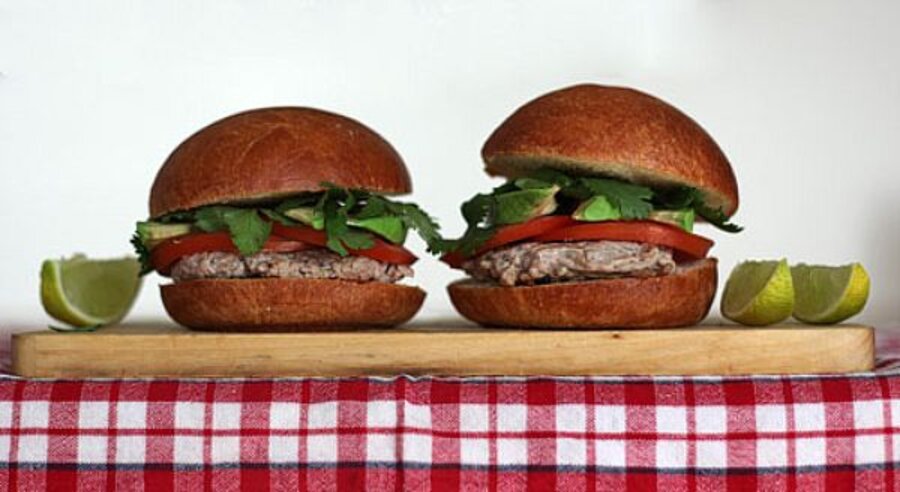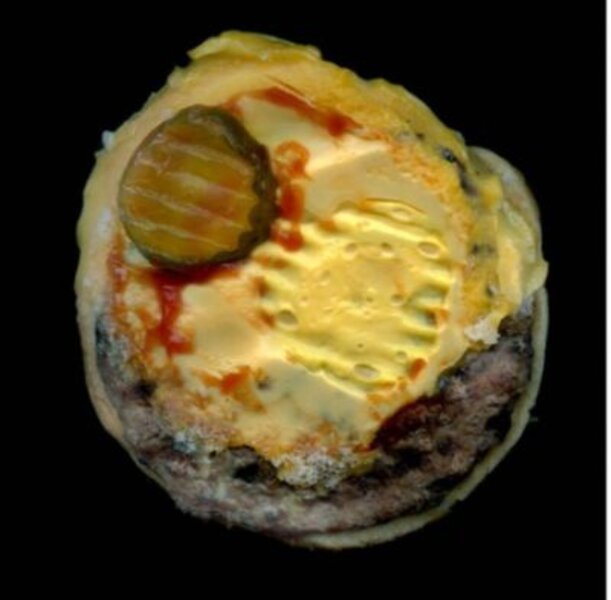Pork and chipotle sliders
Loading...
Jon Feinstein’s 2008 series titled Fast Food features an assortment of sandwiches and sides purchased from chain restaurants. Stripping each foodstuff from a contextualizing background, the food floats against a stark black void – each detail meticulously recorded via the flatbed scanner. For Feinstein, the use of the scanner in place of a camera is twofold; it allows him to render the image in a “rigid, specific and typological manner” and it mirrors the “removal of the hand in food preparation.”[1]
Represented sans the gloss of the company branding, the food is presented un-apologetically to the viewer, pressed against an invisible boundary. Each image is paired with a number followed by "grams" to highlight the amount of fat in each meal, as demonstrated in the photograph 16 grams, conceded by the artist to be a Burger King cheeseburger. According to Feinstein, “These photographs investigate the love/hate relationship that many Americans have with fast food, and like many other aspects of popular culture, its ability to be simultaneously seductive and repulsive.”[2]
Through this series, Feinstein highlights his interest in our “attraction to things that we know are ‘bad’ for us.”[3] In his book, "Fast Food Nation," Eric Schlosser argues that at this point in history, we are conditioned from childhood, through branding and advertising, to seek out fast food. Entire marketing strategies were developed to establish life-long consumer loyalty from childhood. It is through these associations that as educated adults, aware of the health concerns associated with the consumption of fast food, we continue to eat it. Schlosser continues by reasoning that aroma and memory are linked and that a scent has the ability to “evoke a long-forgotten-memory”, with childhood foods leaving “an indelible mark”[4] causing adults to consume them without exactly knowing why.
This could explain Feinstein’s observation in relation to the Fast Food series, “I noticed that even after making the images, free of branding, gloss etc, I still felt myself drawn to eat fast food occasionally. Similarly, as disgusting as many of the images are, when they are exhibited people often describe the photos as making them hungry.”[5]
[1] Feinstein, Jon, email interview, 29 September 2010.
[2] Ibid.
[3] Ibid.
[4] Schlosser, Eric, Fast Food Nation: the Dark Side of the All-American Meal, New York City, Houghton Mifflin, 2001. 123.
[5] Feinstein, Jon, email interview, 29 September 2010.
This text is excerpted from the November 2010 article, ‘Fast Food through the Lens of Still Life Photographers‘ published in Curator.
Pork and Chipotle Sliders
adapted from the June 2009 issue of Gourmet
Yield: 6 sliders
500 grams [about 1 lb.] ground pork
1 chipotle chili, minced
1 teaspoon adobo sauce
1 clove garlic, minced
6 small brioche buns
1 large tomato, sliced
1 small avocado, sliced
Handful of fresh cilantro
Limes, to serve
Mix the pork, chipotle, adobo sauce and garlic in a small bowl. Form in to small patties (the same diameter as the buns) and about 1/2 inch thick. Place a griddle or large frying pan over high heat and once hot, gently fry the patties until cooked through – around 30-45 seconds on each side.
Assemble the sliders with the patty, tomato, avocado, fresh cilantro and a squeeze of lime before serving.
Megan Fizell deconstructs fine art into recipes at Feasting On Art.
Related post: Salt and vinegar sweet potato fries
--------------------------------------------------------------
The Christian Science Monitor has assembled a diverse group of food bloggers. Our guest bloggers are not employed or directed by The Monitor and the views expressed are the bloggers' own and they are responsible for the content of their blogs and their recipes. All readers are free to make ingredient substitutions to satisfy their dietary preferences, including not using wine (or substituting cooking wine) when a recipe calls for it. To contact us about a blogger, click here.






